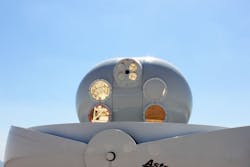If future generations were to live and work on the moon or on a distant asteroid, they would probably want a broadband connection to communicate with home bases back on Earth. They may even want to watch their favorite Earth-based TV show. That may now be possible thanks to a team of researchers from the Massachusetts Institute of Technology’s (MIT) Lincoln Laboratory who, working with NASA last fall, demonstrated for the first time that a data communication technology exists that can provide space dwellers with the connectivity we all enjoy here on Earth, enabling large data transfers and even high-definition video streaming.
At the upcoming Conference on Lasers and Electro-Optics (CLEO: 2014), the team will present new details and the first comprehensive overview of the on-orbit performance of their record-shattering laser-based communication uplink between the moon and Earth, which beat the previous record transmission speed last fall by a factor of 4,800. Earlier reports have stated what the team accomplished, but have not provided the details of the implementation. “This will be the first time that we present both the implementation overview and how well it actually worked,” comments Mark Stevens of MIT Lincoln Laboratory. “The on-orbit performance was excellent and close to what we’d predicted, giving us confidence that we have a good understanding of the underlying physics,” he adds.
The MIT/NASA team made history last year when their Lunar Laser Communication Demonstration (LLCD) transmitted data over the 384,633 kilometers between the moon and Earth at a download rate of 622 megabits per second, faster than any radio frequency (RF) system. They also transmitted data from the Earth to the moon at 19.44 megabits per second, a factor of 4,800 times faster than the best RF uplink ever used. “Communicating at high data rates from Earth to the moon with laser beams is challenging because of the 400,000-kilometer distance spreading out the light beam,” Stevens explains. “It’s doubly difficult going through the atmosphere, because turbulence can bend light -- causing rapid fading or dropouts of the signal at the receiver.”
To outmaneuver problems with fading of the signal over such a distance, the demonstration described in researchers' CLEO presentation uses several techniques to achieve error-free performance over a wide range of optically challenging atmospheric conditions in both darkness and bright sunlight. A ground terminal at White Sands, New Mexico, uses four separate telescopes to send the uplink signal to the moon. Each telescope is about 6 inches in diameter and fed by a laser transmitter that sends information coded as pulses of invisible infrared light. The total transmitter power is the sum of the four separate transmitters, which results in 40 watts of power.
The reason for the four telescopes is that each one transmits light through a different column of air that experiences different bending effects from the atmosphere, Stevens says. This increases the chance that at least one of the laser beams will interact with the receiver, which is mounted on a satellite orbiting the moon. This receiver uses a slightly narrower telescope to collect the light, which is then focused into an optical fiber similar to fibers used in terrestrial fiber-optic networks. From there, the signal in the fiber is amplified about 30,000 times. A photodetector converts the pulses of light into electrical pulses that are in turn converted into data bit patterns that carry the transmitted message. Of the 40-watt signals sent by the transmitter, less than a billionth of a watt is received at the satellite -- but that’s still about 10 times the signal necessary to achieve error-free communication, notes Stevens.
The MIT/NASA team's CLEO: 2014 presentation will also describe how the large margins in received signal level can allow the system to operate through partly transparent thin clouds in the Earth’s atmosphere, which the team views as a big bonus. “We demonstrated tolerance to medium-size cloud attenuations, as well as large atmospheric-turbulence-induced signal power variations, or fading, allowing error-free performance even with very small signal margins,” Stevens adds. While the LLCD design is directly relevant for near-Earth missions and those out to Lagrange points (areas where the forces between rotating celestial bodies are balanced, making them a popular destination for satellites), the researchers predict that it’s also extendable to deep-space missions to Mars and the outer planets.
CLEO: 2014 will be held June 8-13 at California's San Jose Convention Center. Presentation SM4J.1, titled Overview and On-orbit Performance of the Lunar Laser Communication Demonstration Uplink, will take place Monday, June 9, at 4:00 p.m. in meeting room 212 A/C. For more information, visit www.cleoconference.org.
See also: Book takes a deep look at the cabling behind the Internet
